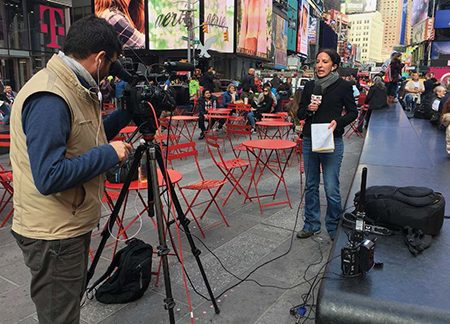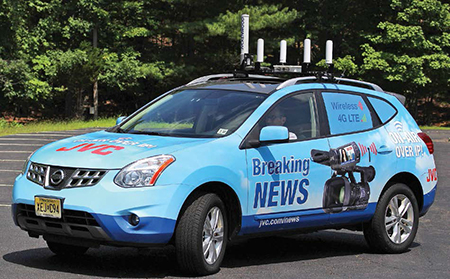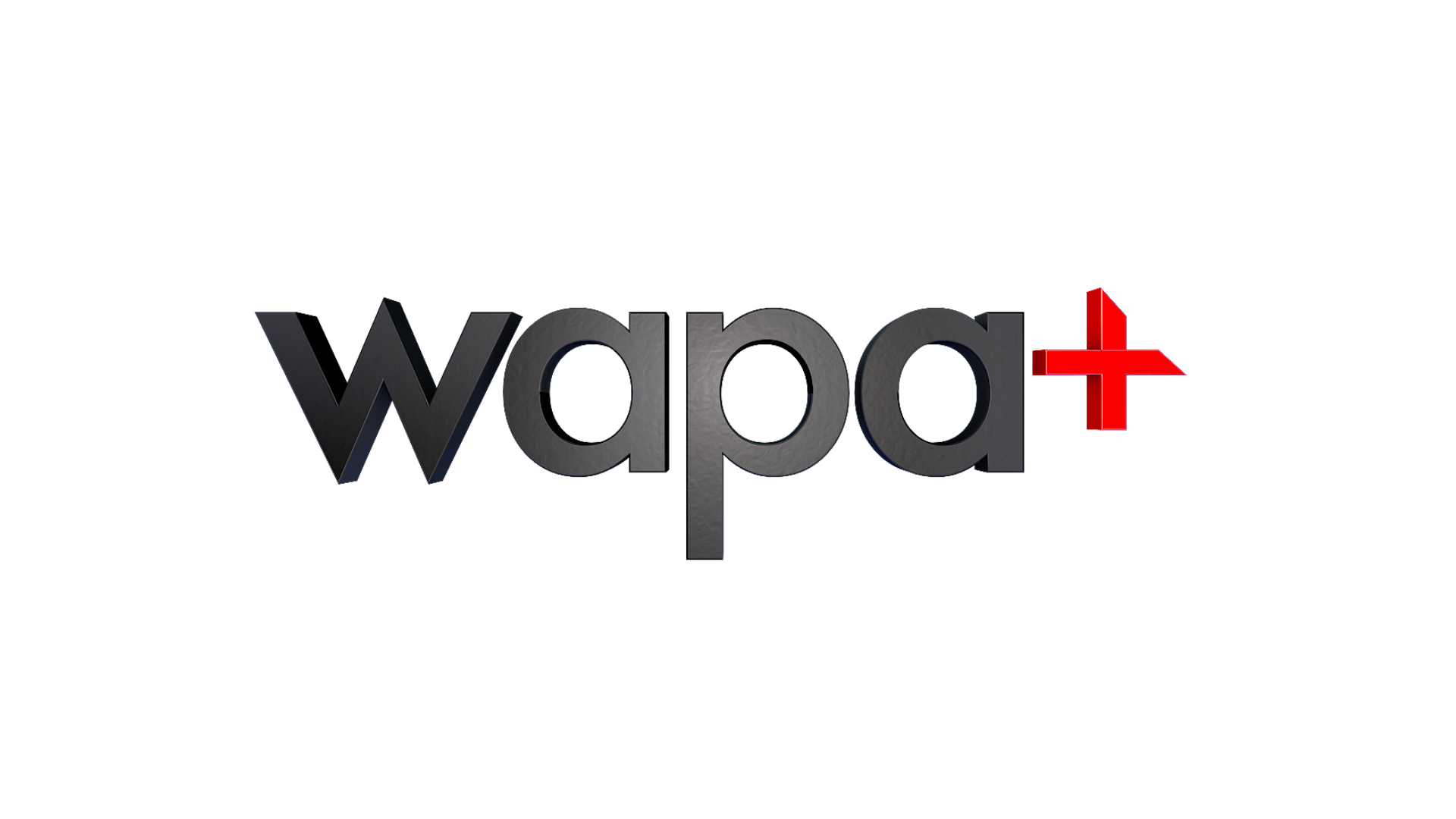Bonded Cellular Shrinks as It Grows
ALEXANDRIA, VA.—Ten years ago, I worked for Sprint Nextel as an engineer on the 2 GHz relocation project (aka the “BAS Relocation”). At that time, broadcasters didn’t have much choice to get signals from remote feeds back to the studio: It was either ENG microwave or satellite trucks.
I stayed with the project until 2010, and although a couple of alternatives were percolating in the background, it wasn’t until a year or two later that they exploded into the minds of broadcasters. It first hit the streets in the form of backpack cellular radios that used multiple 3G cell phone connections to transport signals back to the studio.

A Sky Italia crew uses a Comrex LiveShot system just before Election Day 2016 from Times Square in New York. As telcos such as AT&T, Verizon, Sprint and T-Mobile acquired more spectrum and implemented 4G technology, digital bandwidth that could be used for broadcast-quality video increased rapidly. With two 4G connections paired at the camera, it’s perfectly reasonable to get a transmission channel of 20 Mbps or greater—easily enough for a high-quality link, especially when using H.264 encoding.
Compared to microwave trucks (virtually all of which had been upgraded to digital as a result of the 2 GHz relocation project), bonded cellular has a big advantage: It has high-bandwidth return capability for cuing and IFB built into the system. The big disadvantage of bonded cellular is that the digital link can vary widely from lousy to great—you might be sure you’ll get 20 Mbps, but find out that it won’t go higher than 3 Mbps. As telcos continue to improve their systems and build additional 4G sites, getting higher speeds in the future is almost certain.
Although current 4G technology would seem perfect for occasional broadcast remotes, a 5G standard is in development. It promises to have more efficient spectrum usage and to serve more users with faster data speeds from each cell site.
“We’re really excited to see the rollout of the fifth generation wireless technologies because we’ve been closely involved since the days of 2G and it is amazing to see the bandwidth and technology advancements,” said Avi Cohen, COO and cofounder of Hackensack, N.J.-based LiveU. “But it’s important to remember that these are built for consumers and we are optimizing these networks for professional video applications. We’ve heard this same story through the years—that 3G is going to be fast enough, LTE is going to give us plenty of speed for video, and so on. But as cellular networks get better, the demand for more bandwidth and reliability continues to grow because we keep filling the capacity.”
REDUCED SIZE
As the demand for bandwidth has gone up, the pressure to reduce the size of the cellular encoder/radio has increased as well. LiveU’s LU200 series of cameramount encoders is small, but Cohen sees the future as smaller still.
Get the TV Tech Newsletter
The professional video industry's #1 source for news, trends and product and tech information. Sign up below.
“In more recent years, the need to be even more agile has meant increasing movement towards the device in your pocket; the iPhone, Galaxy or Pixel likely has the best camera you’ve ever owned and can get you more places than a traditional ENG camera,” Cohen said. “This could be the direction that you may see ENG continue to head, and in that regard we’re ready with our LiveU Smart App that enables the user to bond Wi-fi and cellular, and stream directly from the phone’s camera to the receive server, just the way the rest of the LU backpacks do.”
Most bonded cellular products today rely on H.264 encoding, which is well established and efficient. However, the next generation of television encoding—HEVC/H.265—is more efficient and therefore requires less bandwidth for the same quality of delivered video. What does that mean for bonded cellular systems?
“We’ve been keenly following the developments in the world of HEVC/H.265 encoders, and we find the offerings to be wanting,” said Chris Crump, senior director of sales and marketing for Comrex in Devens, Mass. “Although the H.265 spec offers some great technological promise, we’ve found that the currently available encoders are still inferior to the encoding capability of our H.264 encoder/decoder. As we’ve been telling our customers for some time now, we don’t want to add HEVC because it’s the ‘next big thing.’ We’ve got our ear to the ground, though, waiting for the right horse to show up.”
NOT A SURE THING
Anyone with a cellphone knows that a good connection is not always a sure thing, so manufacturers like Ontario, Canada-based Dejero created the Live+ Booster to work around that reality. Live+ Booster is a vehicle-mounted unit with an array of up to 12 high-gain antennas to improve performance. Paired with Dejero’s Live+ Go- Box or 20/20 transmitter, the Live+ Booster is an alternative to satellite or microwave systems that may be blocked by weather or line-of-sight obstructions.

JVC ProHD Bridge is a family of products for ENG links. JVC recently launched a vehicle-mounted system that incorporates diversity antennas to establish a high-reliability channel with bonded cellular. The ProHD Bridge puts the H.264 encoder in the camera, then has a 5 GHz camera-mount transmitter to relay the signal to the vehicle, which then sends the signal off to the studio.
An interesting twist in JVC’s system is that it can also provide a wide-ranging Wi-fi hotspot that can be used for any Internet-based application. ProHD Bridge consists of several products that can be mixed and added as needed.
Irvine, Calif.-based VidOvation’s DMNG PRO180 bonded cellular transmission system can support eight telco modems, has an internal high-efficiency custom antenna array and built-in Wi-fi modem, and features two H.264 video encoders for failsafe operation. The system has been getting lots of production use lately on the A&E series “Live PD.”
Consumer 4K displays have been flying off the shelf this year, and both 4K and high dynamic range have been widely discussed and demo-ed in the industry. Bonded cellular manufacturers have been keeping a close eye on these trends.
“If there is a demand for it now, we can certainly deliver such product very quickly,” said Paul Shen, CEO of TVU Networks in Mountain View, Calif. “There is sufficient bandwidth and stability with TVU mobile uplink solutions to support 4K and HDR video, and the processing power is also there to process those signals.”
What’s in a Name?
The cellular industry—in the form of the big telcos—is not a great friend of broadcasters. For decades, broadcasters controlled a huge swath of spectrum that turned out to be ideal for telcos to press into cellphone service—lobbying, advertising and probably some old-fashioned arm twisting was involved in forcing broadcasters off that spectrum. To be fair, the telcos did pay a lot of money for it, but much of that money went to Uncle Sam and not the broadcasters.
There are several books that could be written about this, but the point is that some broadcasters grumble at the use of products and services that are sold under the name “bonded cellular,” since cellular has been... well, “the enemy.” A few people in this industry probably want to avoid the use of the word “cellular,” and certainly don’t want to be seen bonding with it.
So if it’s not “bonded cellular,” what do we call it? A couple suggestions could be “IP ENG” and “License-Free Remote.” I like the term “Pocket Remote,” since the time is probably not far off when a respectable news remote could be done with a single cellphone.
And “bonded” is quickly becoming passé, as wireless network speeds ramp up. 4G wireless networks are now common, and they theoretically have speeds as high as 100 Mbps. In practice, I routinely get 4G speeds of 15–20 Mbps at my home and once scored 42 Mbps on the road (in Seattle). With the advent of 5G, which promises greater spectral efficiency than 4G and theoretical wireless speeds up to 1 Gbps, the need for bonding multiple channels for a single feed evaporates. (There is no current deployment of 5G, but much work is being done on a standard.)
Even 15 Mbps with H.264 encoding results in a pretty good HD signal back at the studio, and some video industry manufacturers are building gear to make such bandwidth as reliable as possible.
So if it isn’t “bonded cellular,” it certainly won’t be simply “cellular.” My two favorites are “IP ENG” and “Pocket Remote.”
What are yours? Drop us a line at tvtech@nbmedia.com.
Bob Kovacs
THE END OF TRUCKS?
What will become of the thousands of microwave remote trucks operated by broadcasters across the country? Do bonded cellular systems do everything a microwave truck can do, without the need to get an FCC license for microwave operations?
Not exactly.
“Microwave has its niche where cellular coverage has not been deployed or in rare situations of a severely congested environment—although those situations are becoming less common, as the cellular infrastructure continues to improve,” Shen said. “On the other hand, TVU mobile uplink solutions are capable of using cellular, microwave and satellite simultaneously. You can consider that TVU mobile uplink solution is the superset of all those technologies.
“I would be surprised to see anyone today deploying any specific technology without considering leveraging all different transmission mediums, simultaneously. One example is the World Ski Championship in 2015. It had very good cellular coverage throughout the ski slope, except at the very top of the mountain. So, TVU deployed a MIMO-microwave site on top of the mountain. TVU transmitters with integrated MIMO modules continuously delivered full HD-quality live video, while the camera crew skied down from top of the mountain.”
Bonded cellular, a product category that had not yet been invented 10 years ago and had just a handful of customers five years ago, is now a major path for broadcast remotes. Broadcasters have a wary relationship with telco companies (see the sidebar), but reliable remote connections using bonded cellular products could change some attitudes among broadcasters.
As more cell sites are rolled out and broadcaster-friendly bandwidth becomes more available and reliable, routine ENG remotes will increasingly move to bonded cellular links. After all, what once needed a truck will now almost fit in a couple of pockets.
Bob Kovacs is the former Technology Editor for TV Tech and editor of Government Video. He is a long-time video engineer and writer, who now works as a video producer for a government agency. In 2020, Kovacs won several awards as the editor and co-producer of the short film "Rendezvous."

